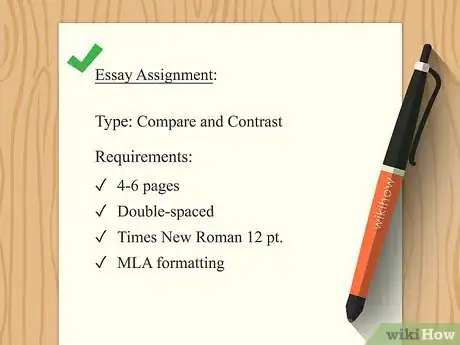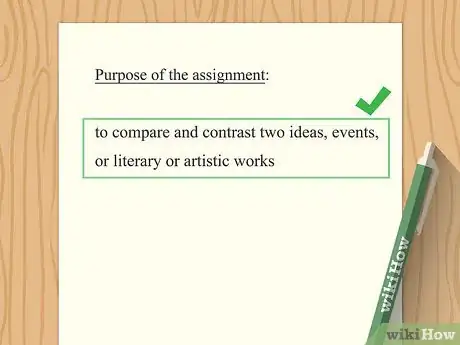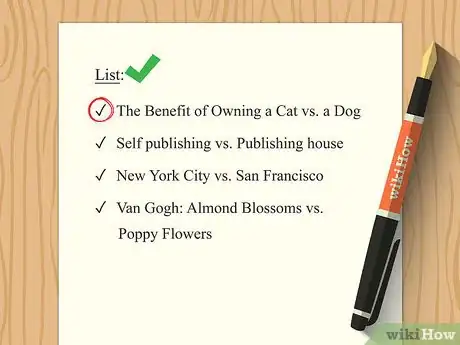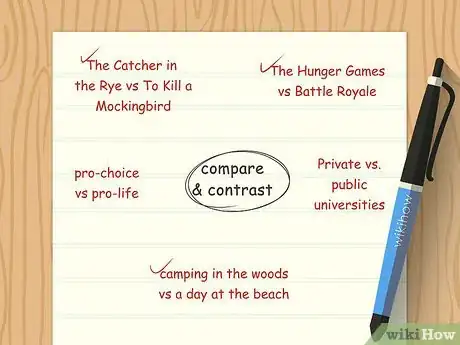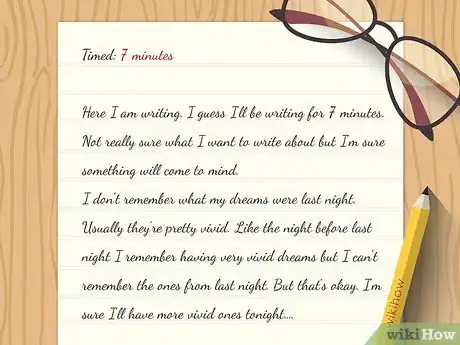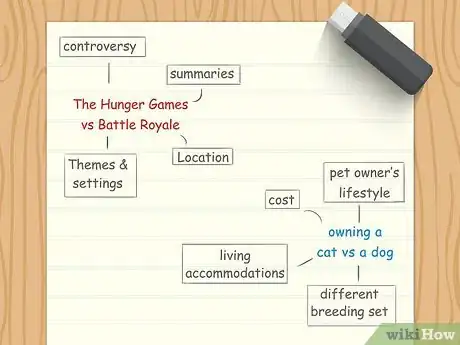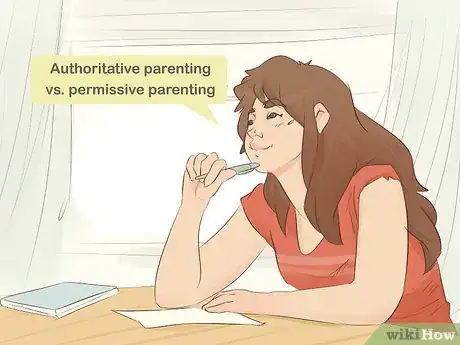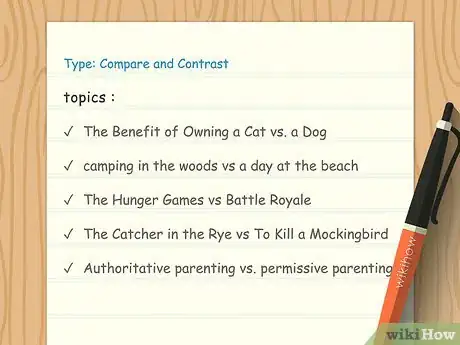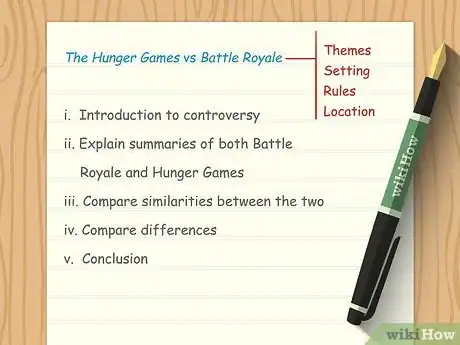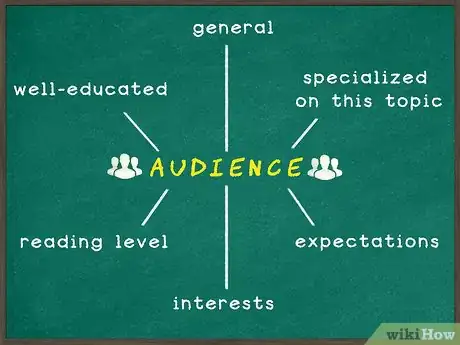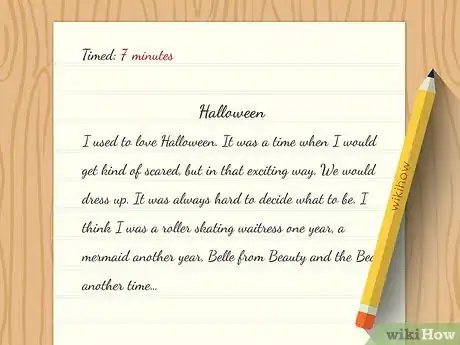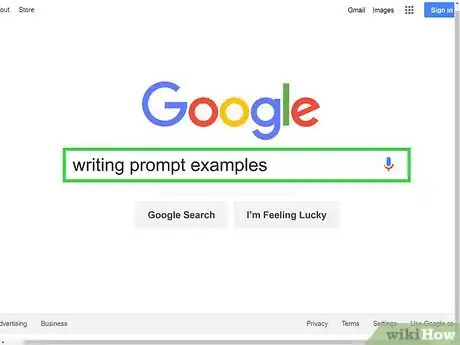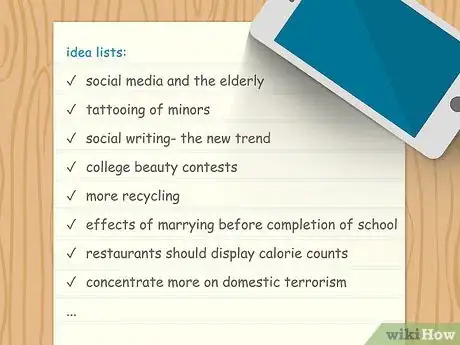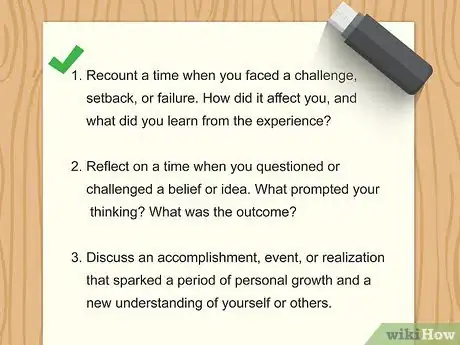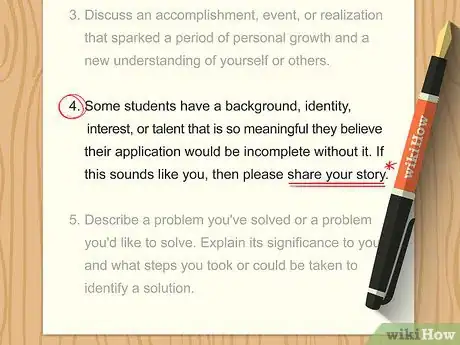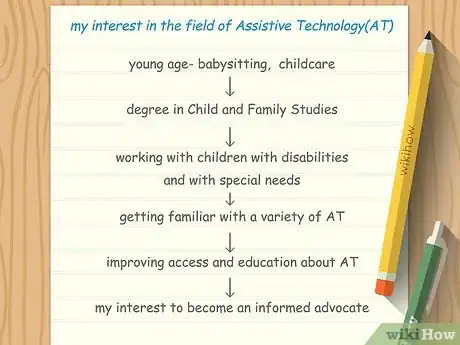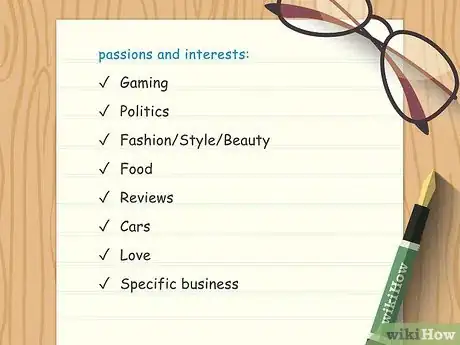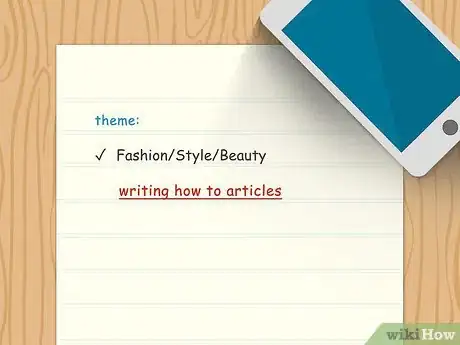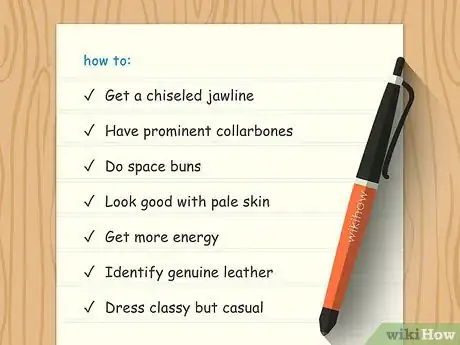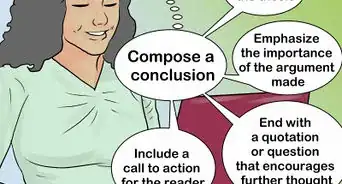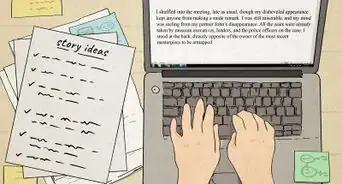This article was co-authored by Michelle Golden, PhD. Michelle Golden is an English teacher in Athens, Georgia. She received her MA in Language Arts Teacher Education in 2008 and received her PhD in English from Georgia State University in 2015.
There are 9 references cited in this article, which can be found at the bottom of the page.
This article has been viewed 89,312 times.
Many people are intimidated by the thought of writing. One of the biggest factors that can contribute to writers’ block is not knowing what to write about. If you can find a topic that interests you, your writing will likely flow more readily and you will be more likely to write a successful piece. Use a variety of strategies for coming up with something to write about to find what works best for your writing and learning style.
Steps
Choosing an Academic Essay Topic
-
1Understand the essay assignment.[1] Understanding the assigned essay is the first step to coming up with a topic. Knowing the type of essay that is expected, the length of the essay, and to what degree research is expected will all determine the scope of the topic you will choose.
-
2Evaluate the purpose of the assignment. The purpose of the assignment will also determine the type of topic.[2] A persuasive essay, for example, will have a much different type of topic than a personal experience essay.
- Look for key action words like compare, analyze, describe, synthesize, and contrast. These words will help you determine what your teacher wants you to do in the essay.
Advertisement -
3Select a topic from a provided list. If your instructor has provided a list of topics for you, choose a topic from the given list. It is likely that the topics have been gathered together because they are an appropriate scope and breadth and the instructor has found that the topics have led to successful essays in the past.
- Try to write a thesis, or central argument, for each of the topics.
- Choose the topic for which the thesis comes most naturally and for which you feel you can develop the paper easily.
-
4Ask if you can write about an alternate topic. If you really feel limited by the list of topics your instructor provided, ask her if you can write about another topic. It’s best to have a specific topic in mind when you go to her to ask about an alternative.[3]
-
5Brainstorm a list of ideas. Write down a list of ideas that come to mind. They don’t have to be good ideas, but it’s good to just start writing a list to get your ideas flowing. Just write down everything you can think of; you can evaluate the ideas later.[4]
-
6Freewrite for a predetermined amount of time. Decide ahead of time how long you want to freewrite, then just write without stopping.
- Most people write for 10-20 minutes.
- Do not stop writing, even if you need to just write “blah blah blah” in the middle of a sentence.
- Hopefully, you will write yourself towards a useful thought or idea through freewriting. Even if it does not give you content you can use in your essay, it can be a valuable writing warm-up.
-
7Create a visual representation of your ideas. Especially if you are a visual learner, creating a visual representation of your ideas may help you stumble onto or narrow down ideas to a good topic.[5]
- Use a mind map. The center of the mind map contains your main argument, or thesis, and other ideas branch off in all directions. [6]
- Draw an idea web. This a visual that uses words in circles connected to other words or ideas. Focusing on the connections between ideas as well as the ideas themselves may help you generate a topic.[7]
-
8Remember what the teacher focused on in class. If you are writing an essay for a class, think about what the teacher spent a lot of time talking about in class. This may make a good choice for an essay, as the teacher clearly thinks it’s something important.
- Review your class notes and see if there is anything that stands out as interesting or important.
- Review any handouts or focus sections of a text that were assigned.
-
9Think about what interests you. Writing something you care about or that you are interested in is much easier than making yourself write about things that seem boring. Make a list of your interests and see if there is a way to connect one or more of them to your essay.
-
10Consider the list you have generated. Write a few additional notes next to each potential topic and evaluate whether each item would be an appropriate topic. At this point, you should be able to narrow your list down to a few good choices.
- You may want to ask your teacher if you have narrowed down your ideas to two or three items. She may have some insight as to which topic would be the most successful.
- Go back and look at the original assignment again and determine which of your narrowed topics will best fit with the intent of the essay assignment.
-
11Limit the scope of your topic appropriately. Once you have decided on a general topic, you will need to be sure that your specific topic or argument has an appropriate scope.
- A focus that is too broad will either make your paper too long or lead to an unsuccessful argument because you haven’t provided enough detail. For example, a topic of “dogs” is too broad for a paper.
- A focus that is too narrow or specific will lead to a short paper that misses a “big picture” argument. For example, a topic of “the adoption rate of one-eyed teacup poodles in [city]” is likely too narrow for a paper.
- An appropriate focus will give you enough space to write about the topic thoroughly. For example, “the effects of puppy mills on stray dog adoption in [State]” may be a better focus.
Choosing a Creative Writing Topic
-
1Identify your audience. The first step to virtually any kind of writing is to know your audience. The audience of your creative writing can determine the topic that you choose to write about.
- Ask yourself what your audience would be interested in reading.
- Think about what may surprise or shock your audience.
- If you are unsure about your actual audience, create a fictional reader in your mind. You could even give your fictional reader a name.
-
2Know what interests you. Writing about what is interesting to you will help your writing flow more easily, help you generate fresh content, and lead to a better final product.
-
3Freewrite about something. It matters less what you freewrite about than that you do it. Pick a situation that seems interesting to you: perhaps a person is lost in the desert, or perhaps they are waiting to find out if they have an illness, or perhaps they are trying to decide whether to tell someone they are in love. Then, freewrite based on that situation, thinking about what might happen, what they might be thinking, conversations they might have, etc.
- Write nonstop for a predetermined amount of time (most people do 10-15 minutes.)
- Do not stop writing, even if you need to just write “blah blah blah” in the middle of a sentence.
- Hopefully, you will write yourself towards a useful thought or idea through freewriting. Even if it does not give you content you can use in your creative writing, it can be a valuable warm-up.
-
4Consult a list of writing prompts. There are whole books of writing prompt ideas for creative writing, and several websites that contain lists of prompts.[8]
- Treat the prompt as a beginning point but don’t be afraid to leave the topic of the prompt.
- Check your library for a book of prompts so that you don’t have to buy one.
-
5Keep an idea list. Keep a list of ideas of things to write about on you all the time. If you think of an idea, write it down. Go to your working list any time you feel like you need help coming up with a topic.
-
6Look around you. Your environment contains a rich array of items that can serve as writing prompts, so just look around and write about something that you see.
- Close your eyes, then open them and write about the first thing you see, regardless of what it is.
- Look at the color of something nearby, and write a list of other things that are the same color until you feel inspired.
- Look at an item near you and try to remember the last time you saw a similar item. Who were you with? What were you doing? Then write a story, real or fictional, about that memory.
- Find a unique item in your line of sight, then imagine that you are seeing it for the first time. Write about someone from a different culture seeing the item for the first time out of context and speculating about what it is used for.
Choosing a College Admission Essay Topic
-
1Read any available prompt very carefully. Find out if the school you’re applying to uses the common application. If so, be sure to select one of the current year’s common application essay questions. Most college application prompts can be identified as one of several “types” of question:
- Tell us about an event in your life that changed you. Be sure to answer this type of question with a specific, detailed narrative and follow it with analysis. Tie it in to who you are now, and be sure to add details about how you think it will shape your future.
- Tell us how you would contribute to the diversity of the student body. Remember that there are different kinds of diversity: racial, gender identity, sexual orientation, and family history. If you are a first-generation college student in your family, that may contribute to the school’s diversity. Find the student body statistics on the college’s website to see if there is a way you would stand out.
- Tell us why you want to attend this school. Be specific and complimentary, but try not to use too much flattery. Use the schools website to find specific programs that are unique to the college that you are interested in participating in. Be sure to tie your goals at college in to your personal strengths.
-
2Rewrite the essay prompt in your own words. Rewriting a prompt in your own words ensures that you really understand it and know what it is asking you to do. If any questions come up while doing this, consult a teacher, guidance counselor, or parent for a second opinion.
-
3Think carefully about the list of topics. Do not just select the topic that jumps out at you on the first read; give the topics some time in your mind.
- Narrow the list down to a couple of options that you think would make good essays.
- Pre-write a list of ideas or draw a mind map for each of the selected topics.
-
4Select a topic that you feel the strongest connection with. While there may be many topics that you could write a successful essay about, if you choose the one that just “feels” right, you’re more likely to put an intuitive personal spin on your essay.
-
5Use a backwards approach. Instead of selecting the essay prompt first, try writing down a list of personal accomplishments, attributes, and stories that you want to include in your essay and then selecting the topic that will help you shine as an applicant.
-
6Say something meaningful and unique. The key to being successful at a college essay is standing out and providing the student body of the college with value of some sort.
- Avoid generic topics or stories and try to really find something to say that highlights who you are as an individual.
- Integrate your strengths and goals into the answer for the question, but be sure to answer the question as well.
- Find out if there are any overused or cliché experiences that may not be successful as a college essay. An example of an overused topic is a charitable mission trip. Your guidance counselor may help you determine what has been overdone.
-
7Show, rather than tell. This is a common mistake in college admissions essays. You can be in such a hurry to tell the admissions committee all of your accomplishments that your essay reads more like a list. Use concrete examples with personal relevance to back up all of your claims.
- For example, don't just say "I have strong leadership skills." This is telling. Instead, use a formula such as this: "My experiences in ____ have developed strong leadership skills." Then write about how you organized cookie sales for your Girl Scouts troop or served as a camp counselor in the summer (or whatever is germane to your claim).
-
8Read through the college website. Determining what seems to be important to the college (such as diversity, community service, or personal integrity) and emphasizing that quality in yourself can make you seem like a good fit for the school.[9]
- Search the college president’s page for a “strategic plan” for the coming years.
- Look at the college mission and vision and try to weave these into your personal values.
- Check the website for special programs or initiatives such as service learning, global leadership, or environmental conservation and integrate these ideas into your own.
Choosing a Topic for a Blog
-
1Evaluate your passions and interests. A blog may be a long-term writing project, so you want to be sure that you will still be interested in the topic of your blog in several months or even years.
-
2Select a theme. Think of your blog as a theme. A theme is a broad set of ideas that revolve around one central, controlling ideas.[10]
- Thinking of your blog as a theme will help you determine an appropriate scope.
- Having a consistent theme with your blog will likely make it more successful because your followers will continue to be interested in what you write about.
-
3Keep an idea list. Like with creative writing, keeping a list of potential topics will give you a “bank” to choose from when you’re ready to write. You may even want to write a few sentences next to some topics that you can flesh out into a whole entry.[11]
-
4Ask your audience. If you have regular subscribers who read and comment on your blog, ask them what they would like you to write about. They may give you a great idea that you would not have thought of yourself.[12]
- Give your readers a list of topics and ask them to comment with one they would like to see.
- Read comments on entries to see if any ideas have been indirectly suggested there.
- If your blog is tied to a social media outlet, try asking on the social media platform what you should blog about. This may seem less awkward than making a blog post asking what to write about.
-
5Stay current with other blogs. If you regularly read other people’s blogs, chances are you will have ideas about what to write about while you are reading. Jot them down in your idea log.
- Be sure to link to blogs that inspire you to write an entry to credit the ideas appropriately.
- Ask another blogger to write a guest post on your page. It may trigger some new ideas in you or your readers.
Community Q&A
-
QuestionI don't want anything bad to happen to my main character, what do I do? I like the character too much.
 Nathan FeldCommunity AnswerYou must learn how to detach from your character to do things to them. The author may love the character, but the reader wants a juicy story. Find a unique way to manipulate your main character.
Nathan FeldCommunity AnswerYou must learn how to detach from your character to do things to them. The author may love the character, but the reader wants a juicy story. Find a unique way to manipulate your main character.
References
- ↑ https://owl.english.purdue.edu/owl/resource/658/03/
- ↑ https://owl.english.purdue.edu/owl/resource/587/01/
- ↑ https://owl.english.purdue.edu/owl/resource/658/03/
- ↑ https://owl.english.purdue.edu/owl/resource/658/03/
- ↑ https://owl.english.purdue.edu/owl/resource/673/01/
- ↑ http://www.studygs.net/writing/prewriting.htm
- ↑ http://www.scholastic.com/teachers/lesson-plan/graphic-organizer-idea-web
- ↑ http://www.dailywritingtips.com/writing-prompts-101/
- ↑ http://inlikeme.com/19-common-application-essay-mistakes-and-how-to-avoid-them/
